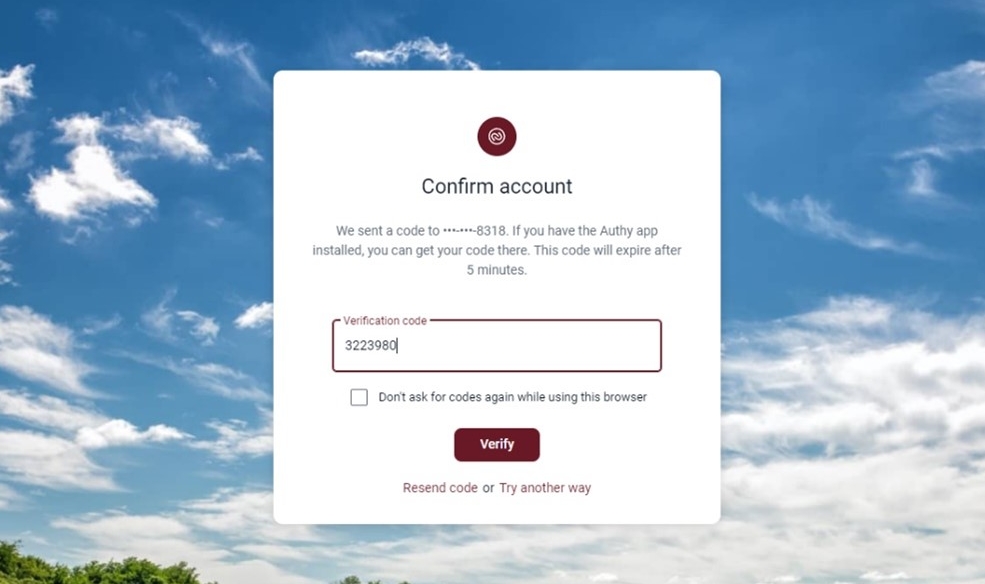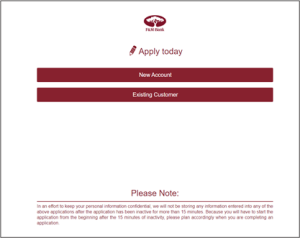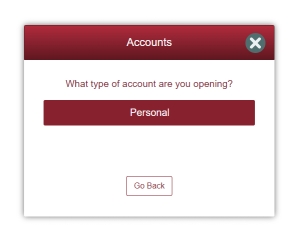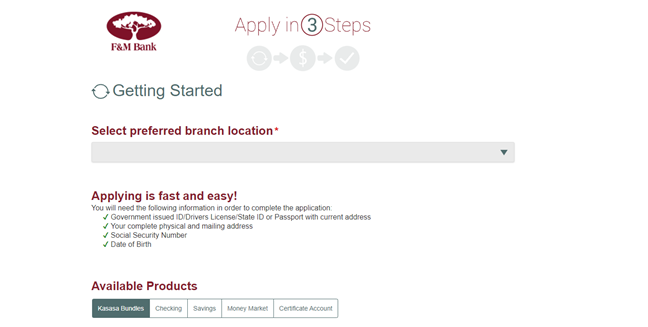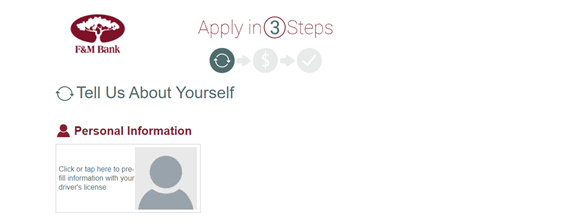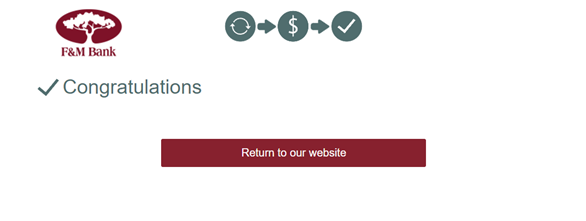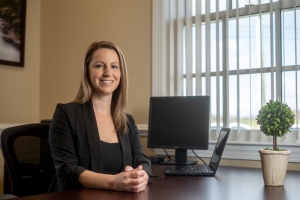F&M Bank Corp Announces First Quarter 2022 Earnings
F & M Bank Corp. News and Financials
TIMBERVILLE, VA—April 25, 2022—F & M Bank Corp. (OTCQX: FMBM), parent company (the Company) of Farmers & Merchants Bank today reported net income of $2.5 million for quarter ending March 31, 2022.
Mark Hanna, President, commented “First quarter of 2022 has been a strong quarter for F&M bank with net income of $2.5 million. Deposits grew this quarter another 2.96% and have been deployed into $3 million of net loan growth, excluding PPP and $58 million of new investments in bonds to capitalize on the rising rate environment. We continue to focus strategically on improving our infrastructure and enhancing our digital experience as we expand our reach to organically acquire new banking relationships. Our greater scale, coupled with improvements in asset quality, position F&M for continued success.”
Selected financial highlights include:
- Net income of $2.5 million for the quarter ended March 31, 2022.
- Total deposit increase of $32.0 million (2.96%) and $249.5 million (28.9%), respectively for the quarter and for the trailing twelve months.
- Loans held for investment increase of $3.0 million (.46%) and $35.1 million (5.64%), respectively for the quarter and for the trailing twelve months (excluding PPP loans).
- Nonperforming assets as a percent of total assets decreased to .39% from .45% at year end and .57% on March 31, 2021.
- Past due loans still accruing decreased to 0.36% of loans held for investment (net of PPP) from 0.49% at year end and 0.52% on March 31, 2021.
- Recovery of Provision for Loan Losses of $450,000 for the quarter.
- Allowance for loan losses of 1.12% of loans held for investment, excluding PPP.
BALANCE SHEET
Loans
Loans held for investment; net of PPP have grown 5.64% since March 31, 2021. The Agriculture, C&I, CRE and dealer portfolios have experienced growth throughout the quarter and year to date, while the Company has seen a reduction in consumer loans specifically in the 1-4 family residential loan area.
| LOAN PORTFOLIO | |||||
| (dollars in thousands) | 3/31/2022 | 12/31/2021 | Change | 3/31/2021 | Change |
| Commercial | $ 290,452 | $ 286,500 | $ 3,952 | $ 267,792 | $ 22,660 |
| Agriculture | 82,460 | 81,879 | 581 | 70,556 | 11,904 |
| Dealer | 111,238 | 107,346 | 3,892 | 96,370 | 14,868 |
| Consumer | 169,617 | 173,556 | (3,939) | 183,046 | (13,429) |
| Other | 3,733 | 5,205 | (1,472) | 4,608 | (875) |
| Loans held for Investment, net of PPP | $ 657,500 | $ 654,486 | $ 3,014 | $ 622,372 | $ 35,128 |
Investments
The Company has continued to leverage excess funds into the available for sale (AFS) investment portfolio in the first quarter of 2022 growing $57.9 million to $462 million. The portfolio is a strong mix of U.S. Treasuries, Agencies, Mortgaged-backed securities, Municipals, and Corporate bonds. The average tax equivalent yield on the portfolio is 1.54% which has equated to $1.5 million in income for the first quarter compared to $461 thousand in the same quarter last year.
| AFS INVESTMENT PORTFOLIO | |||||
| (dollars in thousands) | 3/31/22 | 12/31/21 | Change | 3/31/21 | Change |
| US Treasury | $ 42,868 | $ 29,482 | $ 13,386 | $ 29,421 | $ 13,447 |
| Agency | 158,540 | 133,714 | $ 24,826 | 24,877 | $ 133,663 |
| Mortgage-Backed Securities | 197,594 | 183,647 | $ 13,947 | 85,406 | $ 112,188 |
| Municipals | 32,674 | 34,337 | $ (1,663) | 20,692 | $ 11,982 |
| Corporates | 30,146 | 22,702 | $ 7,444 | 11,307 | $ 18,839 |
| Total Securities | $ 461,822 | $ 403,882 | $ 57,940 | $ 171,703 | $ 290,119 |
| Securities Quarterly Income | $ 1,497 | $ 1,102 | $ 395 | $ 461 | $ 1,036 |
Deposits
The Company’s deposit growth during the first quarter of 2022 has been in noninterest bearing accounts ($17.6 million) and money market accounts and savings accounts ($21.1 million) with a decline in NOW and other transactional accounts ($3.6 million) and time deposits ($3.2 million). The Company continues to strategically focus on building primary banking relationships.
| DEPOSIT PORFOLIO | |||||
| (dollars in thousands) | 3/31/22 | 12/31/21 | CHANGE | 3/31/21 | CHANGE |
| Non Interest Bearing | $ 298,676 | $ 280,993 | $ 17,683 | $ 252,265 | $ 46,411 |
| NOW & Other Transactional | 188,342 | 191,969 | (3,627) | 119,076 | 69,266 |
| Money market and Savings | 504,611 | 483,476 | 21,135 | 363,377 | 141,234 |
| Certificates of deposit | 120,666 | 123,857 | (3,191) | 128,034 | (7,368) |
| Total Deposits | $ 1,112,295 | $ 1,080,295 | $ 32,000 | $ 862,752 | $ 249,543 |
Asset Quality
Nonperforming loans as a percent of total assets (net of PPP) continue to decline from 0.57% on March 31, 2021 to 0.39% at March 31, 2022. In addition, classified loans and past due loans declined from the previous twelve months from 9.69% to 6.17% and 0.52% to 0.36%, respectively (net of PPP).
| (dollars in thousands) | 3/31/2022 | 12/31/2021 | 3/31/2021 |
| Non-performing Loans | |||
| Non-accrual loans | $ 4,751 | $ 5,465 | $ 5,755 |
| Over 90 & on Accrual | 48 | 43 | 28 |
| Total Non-performing Loans | $ 4,799 | $ 5,508 | $ 5,783 |
| NPL As A % of Total Assets, net of PPP | 0.39% | 0.45% | 0.57% |
| Watch Total | $ 21,901 | $ 24,140 | $ 30,681 |
| As A % Of Loans, net of PPP | 3.31% | 3.67% | 4.88% |
| Substandard Total | $ 18,969 | $ 19,713 | $ 30,179 |
| As A % Of Loans, net of PPP | 2.86% | 2.99% | 4.80% |
| Total Watch List | $ 40,870 | $ 43,853 | $ 60,860 |
| Total Classified As A % of Total Loans, net of PPP | 6.17% | 6.66% | 9.69% |
| Past Due Loans | |||
| 30-59 Days Past Due | $ 2,093 | $ 2,751 | $ 2,730 |
| 60-89 Days Past Due | 273 | 432 | 495 |
| 90+ Days Past Due | 48 | 43 | 28 |
| Total Past Due Loans | $ 2,414 | $ 3,226 | $ 3,253 |
| Deliquency %, net of PPP | 0.36% | 0.49% | 0.52% |
Allowance for Loan and Lease Losses
The allowance for loan losses as a percentage of loans held for investment, net of PPP has declined from 1.56% at March 31, 2021 to 1.12% at March 31, 2022. This decline has been driven by improved asset quality in regard to non-performing, classified and past due loans. Uncertainty in the economy related to the war in Ukraine, inflation and supply chain issues were factored into the allowance for loan losses this quarter as well as growth in the portfolio over the trailing twelve months. The resulting reversal of provision was accretive to quarterly earnings by $450 thousand.
| 3/31/2022 | 12/31/2021 | 3/31/2021 | |
| (dollars in thousands) | |||
| Provision for Loan Losses | $ (450) | $ (590) | $ (725) |
| Allowance for Loan and Leases Losses | $ 7,389 | $ 7,748 | $ 9,704 |
| ALLL as a % of Loans Held for Investment, net of PPP | 1.12% | 1.18% | 1.56% |
INCOME STATEMENT
Net Interest Income
Net interest income reflects growth over the year ended 12/31/21 and quarter ended 3/31/21 of $177 thousand and $380 thousand, respectively. As yields on earning assets continue to decline the Company has been able to support net interest income with savings in interest expense and growth in the investment portfolio while seeking opportunities to leverage the growth in liquidity into higher yielding assets. During the quarter the Company was able to purchase bonds as the market yields climbed. This should add to net interest income in future quarters.
Margin compression has reduced the net interest margin from 3.44% on March 31, 2021, to 2.82% on March 31, 2022. To mitigate this compression, the Company has continued to invest excess funds into securities with better yields. The Company has also slightly reduced cost of funds since March 31, 2021 to 34 basis points through maintaining deposit rates, debt reduction and growth in noninterest bearing deposits.
Noninterest Income
Noninterest income of $2.5 million for the quarter was slightly higher than year end 12/31/21 of $2.4 million but a decline from March 31, 2021, which was $3.4 million. Mortgage originations have declined as rates have increased, as a result the Company is focused on expanding mortgage originators into our newer markets, continuing to utilize our title company and growing our wealth management division.
Noninterest expense
Focusing on infrastructure enhancements, digital processes and expanding into our newer markets has resulted in growth in noninterest expense of 11.25% in the trailing twelve months. Some of the growth is attributed to the charitable donation of a property to the local community, disposing of non-income producing properties and eliminating outdated products.
Paycheck Protection Program
The Company processed 1,080 Paycheck Protection Program (“PPP”) & CARES Act loans during 2020 and 2021 totaling $87.1 million. Fees associated with these loans are amortized over the life of the loan or recognized fully when repaid or forgiven. The Company holds $2.1 million in PPP loans as of March 31, 2022 and recognized $169,000 in PPP fee income in the first quarter.
Dividends Declaration
| On April 21, 2022, our Board of Directors declared a fourth quarter dividend of $.26 per share to common shareholders. Based on our most recent trade price of $30.00 per share this constitutes a 3.47% yield on an annualized basis. The dividend will be paid on May 30, 2022, to shareholders of record as of May 15, 2022.”
F & M Bank Corp. is an independent, locally owned, financial holding company, offering a full range of financial services, through its subsidiary, Farmers & Merchants Bank’s thirteen banking offices in Rockingham, Shenandoah, and Augusta Counties, Virginia and the city of Winchester, VA. The Bank also provides additional services through a loan production office located in Penn Laird, VA, a loan production office in Winchester, VA and through its subsidiaries, F&M Mortgage and VSTitle, both of which are located in Harrisonburg, VA. Additional information may be found by contacting us on the internet at www.fmbankva.com or by calling (540) 896-1705.
F & M Bank Corp. Key Statistics
(1) The net interest margin is calculated by dividing tax equivalent net interest income by total average earning assets. Tax equivalent interest income is calculated by grossing up interest income for the amounts that are nontaxable (i.e. municipal securities and loan income) then subtracting interest expense. The tax rate utilized is 21%. The Company’s net interest margin is a common measure used by the financial service industry to determine how profitable earning assets are funded. Because the Company earns nontaxable interest income from municipal loans and securities, net interest income for the ratio is calculated on a tax equivalent basis as described above. (2) The efficiency ratio is not a measurement under accounting principles generally accepted in the United States. The efficiency ratio is a common measure used by the financial service industry to determine operating efficiency. It is calculated by dividing non-interest expense by the sum of tax equivalent net interest income and non-interest income excluding gains and losses on the investments portfolio and Other Real Estate Owned. The Company calculates this ratio in order to evaluate how efficiently it utilizes its operating structure to create income. An increase in the ratio from period to period indicates the Company is losing a greater percentage of its income to expenses.
This press release may contain “forward-looking statements” as defined by federal securities laws, which may involve significant risks and uncertainties. These statements address issues that involve risks, uncertainties, estimates and assumptions made by management, and actual results could differ materially from the results contemplated by these forward-looking statements. Factors that could have a material adverse effect on our operations and future prospects include, but are not limited to, changes in interest rates, general economic conditions, legislative and regulatory policies, and a variety of other matters. Other risk factors are detailed from time to time in our Securities and Exchange Commission filings. Readers should consider these risks and uncertainties in evaluating forward-looking statements and should not place undue reliance on such statements. We undertake no obligation to update these statements following the date of this press release.
|
|||||||||||||||||||||||||||||||||||||||||||||||||||||||||||||||||||||||||||||||||||||||||||||||||||||||||||||||||||||||||||||||||||||||||||||||||||||||||||||||||||||||||||||||
SOURCE: F & M Bank Corp.
CONTACT: Carrie Comer EVP/Chief Financial Officer
540-896-1705 or ccomer@fmbankva.com






